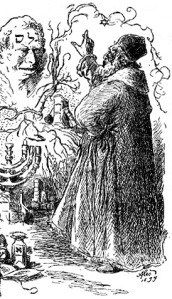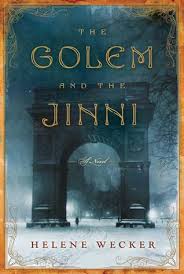 According to Jewish legend, in the late 16th century the rabbi Joseph Loew ben Bezalel of Prague, known by his acronym as the Maharal, fashioned a mythic creature out of clay from the banks of the Vlatava and animated it through a series of mystical incantations. This creature, known in Jewish folklore as a golem, is the most famous incarnation of that monster of the Jewish imagination. Stories abound about the golem of Prague: he defended the Jews against expulsion or pogroms; he fell in love and went berserk; his remains lie in the attic of the Alt-Neu Shul. Most tales about golems in general, however, agree on at least two consistent elements of their natures: their obedience to their masters, whom they serve like slaves, and their propensity for violence in the face of an affront.
According to Jewish legend, in the late 16th century the rabbi Joseph Loew ben Bezalel of Prague, known by his acronym as the Maharal, fashioned a mythic creature out of clay from the banks of the Vlatava and animated it through a series of mystical incantations. This creature, known in Jewish folklore as a golem, is the most famous incarnation of that monster of the Jewish imagination. Stories abound about the golem of Prague: he defended the Jews against expulsion or pogroms; he fell in love and went berserk; his remains lie in the attic of the Alt-Neu Shul. Most tales about golems in general, however, agree on at least two consistent elements of their natures: their obedience to their masters, whom they serve like slaves, and their propensity for violence in the face of an affront.
Everybody, it seems, loves a good golem. Contemporary American literature is peppered with them – Michael Chabon’s The Amazing Adventures of Kavalier and Clay, Cynthia Ozick’s The Puttermesser Papers – and modern Hebrew and Yiddish literature have produced too many belletristic incarnations of the golem to list here. The golem, whose very existence is fraught, has been a potent symbol for writers interested in addressing questions about the nature of creation, sentience, and humanity. Enter Helene Wecker’s The Golem and the Jinni, which ingeniously pairs the golem with a legendary creature of another tradition, the jinn, also known as the genie, of the Arab world.
 In this case, the two meet in the most likely place possible: New York. Where else could two such different creatures come into contact but in the immigrant bustle of turn-of-the-century Manhattan (the 20th century, that is). Although The Golem and the Jinni makes liberal use of the supernatural, both in the form of golem and jinni and in the form of some ancient magic that’s invoked in the last, breathless, thrilling chapters, there is nothing particularly supernatural about the story itself. It’s not a work of fantasy but resolutely realist in its orientation, and perhaps that’s what makes it so compelling. This novel is interested in the human development of golem and jinni, in the ways they are like us, which seem to number more than the ways they differ.
In this case, the two meet in the most likely place possible: New York. Where else could two such different creatures come into contact but in the immigrant bustle of turn-of-the-century Manhattan (the 20th century, that is). Although The Golem and the Jinni makes liberal use of the supernatural, both in the form of golem and jinni and in the form of some ancient magic that’s invoked in the last, breathless, thrilling chapters, there is nothing particularly supernatural about the story itself. It’s not a work of fantasy but resolutely realist in its orientation, and perhaps that’s what makes it so compelling. This novel is interested in the human development of golem and jinni, in the ways they are like us, which seem to number more than the ways they differ.
At the heart of this exploration is a familiar question to us all, especially parents: how much of who we (or our children) are is nature, and how much nurture? Are we born (or created) whole, or do we become who we are through our interactions with those around us, our loved ones and our community? The golem, called Chava, was created to be obedient to one man. But after her master dies on the ocean voyage to America, she’s at loose ends. Able to sense the desires of everyone around her, programmed to conform and obey, yet in possession of intellect and curiosity, the golem struggles to contain her own impulses. Inversely, the jinni, called Ahmad, has been imprisoned by a wizard in human form for over a thousand years. In his natural state the jinni is a loner, literally a free spirit, with tremendous physical and magical power. Stuck in a human body, with all of its frailties and demands, the jinni fights against the containment of his impulses.
The golem and the jinni thus embody an old conflict between free will and determinism, here overlaid with a parallel conflict between individual and community. Both of them represent natural impulses – for the golem, violence; for the jinni, sex – unfettered in nature (and the world of the supernatural) but brought under control by community mores and customs. This causes both internal unrest, as the golem and the jinni try to live in the human world, and trouble between them as they slowly become friends, two aliens disguised in human form. As the golem puts it, “We’re our natures, you and I.”
In the end, though, both golem and jinni prove to be something more than their natures. Given human characteristics, they are also able to make human choices. The actual humans in the story are also awakened to the power that inheres in choice. As the many threads of the plot come together Owen-Meany style, one of the peripheral characters makes a heroic choice that reminds us, even in a story in which so much seems inevitable, that not everything is predetermined. (If this sounds vague, it’s because I’m trying desperately not to reveal any spoilers; it would be a shame not to enjoy the story for yourself.)
Of course, the golem and the jinni are also a metaphor for the masses of immigrants arriving at Ellis Island every day, all of whom struggle to fit into American culture and society, living in the way stations of their insular linguistic and cultural communities. In what is perhaps too pat an ending, the golem and the jinni, individually, together, and with their wider communities, make their peace with their situation. Sometimes the novel seemed to gloss over what a central problem: the way golem and jinni effortlessly cross a seemingly uncrossable boundary between Little Syria and the Lower East Side, between Christian and Jew, Arab and European. But if we see the novel as a kind of American parable, the ending makes sense. Golem and jinni assimilate. Two people, two communities, who otherwise would never mix meet and form connections unimaginable anywhere else, perhaps, other than here.
